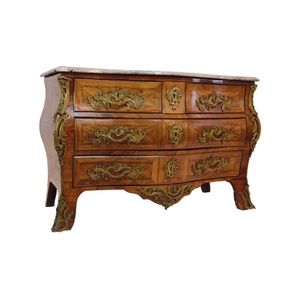19th Century Louis XV Style Bombe Commode
You must be a subscriber, and be logged in to view price and dealer details.
Subscribe Now to view actual auction price for this item
When you subscribe, you have the option of setting the currency in which to display prices to $Au, $US, $NZ or Stg.
- Commode - The word "commode" when used to describe an item of furniture, has three usuages:
1. As used to describe an item of English furniture, it refers to what is euphemistically called a 'night table', that is a small cabinet concealing a chamber pot.
2. In its 18th century French usuage it describes a low and highly decorated chest of drawers for salons and reception rooms. A bombe commode is a commode with rounded sides and front, giving the chest a somewhat swollen look.
3. It is also used to denote a half round or serpentine shaped cabinet, with panelled doors, standing on legs. They were pieces on which the cabinetmaker lavished his most accomplished art, with rich veneers, marquetry inlays, gilt mounts and other ornamentation. - Parquetry - Parquetry is inlay laid in geometric patterns, the contrast being achieved by the opposing angles of the grain and veneers. The herringbone pattern is the most commonly used in flooring, but this is almost never seen in furniture - the patterns used are more complex and unlike flooring, can include several different varieties of timber.
- Apron - A decorative wooden panel that sits underneath the top surface of a table or chair, and unites the top of the piece with the legs, running at right angles to the underside. On carcase furniture such as a chest or wardrobe, the apron sits below the drawers or doors and attaches to the legs.
On carcase furniture without legs the panel under the drawers or doors sits on the floor and is termed a plinth.
An apron can provide a decorative touch to an otherwise unadorned piece of furniture and at the same time provide structural support and strength. They can be carved or pierced and quite elaborate. - Bombe Front - More commonly associated with a dome shaped dessert, "bombe" in furniture parlance means "puffed out". In profile the piece is serpentine shaped, narrow at the top, swelling out towards the middle and continuing to the floor, though sometimes it narrowed again at the foot. Drawer fronts are curved in section. Bombe pieces are often highly decorated with marquetry inlay, or veneered and set with brass or ormolu mounts. The most common use of the word, is in the description of the 'bombe commode'.
The bombe design was particularly popular in the 18th century, during the reign of Louis XIV, when it was used to create furniture pieces with a curved, rounded bulging shape. This design was used on furniture in many styles, including Baroque, Louis XIV, Louis XV and Louis XVI. The bombe chest is one of the most iconic furniture piece featuring this design. They were usually made of precious woods like mahogany, rosewood, and walnut, and feature elaborate inlay, gilded ornaments and ormolu. Other items of furniture where the bombe design can be seen include cabinets, commodes, and desks. - Mounts - Mounts are used to describe bronze, brass and ormolu adornments on furniture especially quality furniture in the rococo and classical revival style, and are also the cabinet makers' name for the metal fittings on furniture, such as hinges, locks and handles, and metal edges and guards which protect furniture from damage.
- Serpentine - Resembling a serpent, in the form of an elongated 'S'. A serpentine front is similar to a bow front, except that the curve is shallow at each end, swelling towards the middle. The term presumably derives from its similarity to a moving snake or serpent. Serpentine fronts are usually veneered, with the carcase either being cut and shaped from a solid piece of timber, or built in the 'brick' method.
- Ormolu - Ormolu was popular with French craftsmen in the 18th and 19th century for ornamental fittings for furniture, clocks and other decorative items. True ormolu is gilt bronze, that is bronze that has been coated with gold using a mercury amalgam. Due to the health risks associated with using mercury, this method of creating ormolu was discontinued in France in the 1830s. A substitute was developed consisting of about 75% copper and 25% zinc, however it was inferior to the bronze version. It was often lacquered to prevent it tarnishing.
This item has been included into following indexes:
-
chests of drawers, period
- Louis style 481
- Victorian 1,199
- commodes and chests, country of origin / style - Louis XV 289
- commodes and chests, finish - marquetry / parquetry inlaid 243
Visually similar items

An important marble top serpentine kingwood commode, French Regence, early 18th century, with fine ormolu mounts and escutcheons, 82 cm high, 128 cm wide, 64 cm deep

A Louis XV rosewood and bronze mounted bombe commode, French 18th century. 88 cm high 130 cm wide, 68 cm deep

A French Louis XV serpentine fronted walnut bombe commode, 18th century, 89 cm high, 130 cm wide, 67 cm deep

A French provincial style commode, the bombe base with three full length drawers with gilt metal handles above cabriole supports, 120 x 90 x 58 cm
